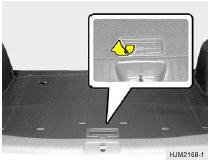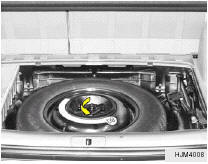Hyundai Tucson: Spare tire
TEMPORARY SPARE TIRE
The following instructions for the temporary spare tire should be observed: 1. Check inflation pressure as soon as practical after installing the spare tire, and adjust to the specified pressure. The tire pressure should be periodically checked and maintained at the specified pressure while the tire is stored.
Spare Tire Pressure
| Tire Size | Type A | T155/90R16 |
| Type B, C | T155/90D16 | |
| Inflation Pressure | 60 psi (420 kPa) | |
2. The spare tire should only be used temporarily and should be returned to the luggage compartment as soon as the original tire can be repaired or replaced. 3. Continuous use at speeds of over 50 mph (80 km/h) is not recommended. 4. As the temporary spare tire is specifically designed for your vehicle, it should not be used on any other vehicle. 5. The temporary spare tire should not be used on any other wheels, nor should standard tires, snow tires, wheel covers or trim rings be used with the temporary spare wheel. If such use is attempted, damage to these items or other car components may occur. 6. The temporary spare tire pressure should be checked once a month while the tire is stored.
CAUTION: o Do not use snow chains with your temporary spare tire. o Do not use more than one temporary spare tire at a time. o Do not tow a trailer while the temporary spare tire is installed.
WARNING: The temporary spare tire is for emergency use only. Do not operate your vehicle on this temporary spare at speeds over 50 mph (80 kmh). The original tire should be repaired or replaced as soon as is possible to avoid failure of the spare possibly leading to personal injury or death.
 Handling the Spare Tire
Handling the Spare Tire
To remove the spare tire
1. Open the tail gate. 2. Remove the luggage mat. 3. Remove the luggage under tray.

4. Turn the installation bolt counterclockwise with a wheel nut wrench to remove the spare tire. After replacing the spare tire, install and tighten the bolt firmly with your fingers until there is no more play in the spare tire.
If you have a flat tire
If a tire goes flat while you are driving: 1. Take your foot off the accelerator pedal and let the car slow down while driving straight ahead. Do not apply the brakes immediately or attempt to pull off the road as this may cause a loss of control. When the vehicle has slowed to such a speed that it is safe to do so, brake carefully and pull off the road. Drive off the road as far as possible and park on firm, level ground. If you are on a divided highway, do not park in the median area between the two traffic lanes. 2. When the car is stopped, turn on your emergency hazard flashers, set the parking brake and put the transaxle in "P" (automatic) or reverse (manual transaxle). 3. Have all passengers get out of the vehicle. Be sure they all get out on the side of the vehicle that is away from traffic. 4. Change the tire following the instructions provided on the following pages.
See also:
Windshield defrosting and defogging
Manual climate control system To defog inside windshield 1. Select any fan speed
except “0”. 2. Select desired temperature. 3. Select the or position. 4. The outside
(fresh) air position is automatically selected. If the outside (fresh) air ...
Parking brake
1 Sets the parking brake
Fully apply the parking brake while depressing the brake pedal.
2 Releases the parking brake
Slightly raise the lever and lower it completely while pressing the button.
■Usage in winter time
See “Winter drivi ...

 Tire pressure monitoring system (TPMS)
Tire pressure monitoring system (TPMS)